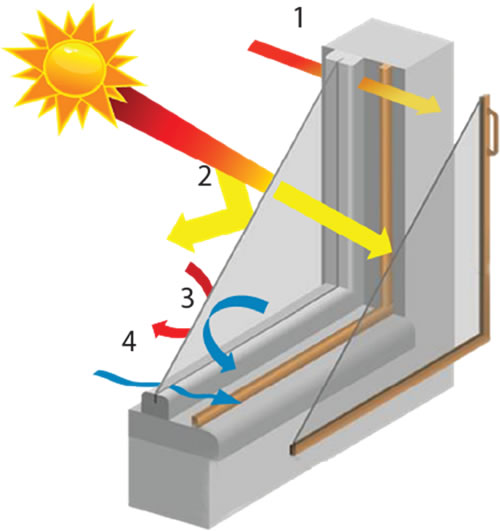How does heat travel through windows?

Heat moving through an object (i.e. heat will travel through an aluminium, or steel frame more easily than through a timber or PVC frame).
2. Radiant heat
Heat from the direct sun. It can pass through space until reflected or absorbed.
3. Convection
Heat flow resulting from air movement e.g. either 'natural' convection - warm air rises, or 'forced' convection - a breeze by a window, both can result in a draught by a window.
4. Infiltration
Air leaks around the frame, around the window sash and through the gaps in the movable window parts.
When evaluating your options to improve the thermal performance of your windows, the following double glazing key performance criteria should be considered:
- U-Value (Uw) represents heat transfer through a window, irrespective of direct sunlight. The lower a window’s U-Value, the better the insulation performance.
- Solar Heat Gain Coefficient (SHGC) measures the solar energy that passes through glazing. The lower the SHGC, the less solar heat is transmitted through a window.
- Air Infiltration or leakage measures the rate at which air passes through gaps in window joins and seals. The lower the air infiltration, the better a window’s energy performance.
The Window Energy Rating Scheme (WERS) Thermal Performance
Aluminium Frame Windows
| Glazing Type | Cooling Stars | Heating Stars | Cool% | Heat% | Uw | SHGC |
|---|---|---|---|---|---|---|
| Single glazed 3mm clear glass* |  |   | 7.4 | 0.77 | ||
| Single glazed 3mm clear glass & 4.5mm Magnetite |    |       | 35% | 59% | 2.9 | 0.67 |
Timber Frame Windows
| Glazing Type | Cooling Stars | Heating Stars | Cool% | Heat% | Uw | SHGC |
|---|---|---|---|---|---|---|
| Single glazed 3mm clear glass* |   |     | 20% | 28% | 5.5 | 0.69 |
| Single glazed 3mm clear glass & 4.5mm Magnetite |    |       | 37% | 61% | 2.6 | 0.66 |
| Single glazed 3mm clear glass with Solartite** and 4.5mm Magnetite |        |      | 76% | 45% | 1.8 | 0.20 |
*WERS standard typical industry window
**Solartite is a range of high performance window film. The window tested above has Solartite’s low-e film.
Magnetite vs Traditional Double Glazing – What the experts says
Winter - the ideal situation is to let in as much of the sun's heat and then trap it inside to maintain a comfortable environment in your home or office. This will also significantly reduce heating costs and saves you money. The ideal window for winter will have a high SHGC to let the sun's heat in and a low U-Value to prevent the heat from escaping. Clear windows without shading films are better suited for winter climates.
Compared with traditional double-glazing, Magnetite’s double-glazing solution can provide better results during winter or for cold climate areas such as Canberra, the Adelaide Hills and Blue Mountains.
Magnetite's clear acrylic window panels allow the direct heat from the sun's rays to enter the building and once inside, Magnetite's superior magnetic seals retain the heat, giving Magnetite an advantage over conventional operating windows.
| Glazing Type | Cooling Stars | Heating Stars | Cool% | Heat% | Uw | SHGC | AI |
|---|---|---|---|---|---|---|---|
| Double Glazed 3mm clear glass/12mm air gap/3mm clear glass IGU (Insulated Glass Unit)* |    |       | 40% | 55% | 3.0 | 0.61 | 5.0 |
| Single glazed 3mm clear glass & 4.5mm Magnetite |    |       | 37% | 61% | 2.6 | 0.66 | 0.5 |
*WERS standard typical industry window
Summer - the ideal situation is to minimize the heat coming in from outside and prevent the cool air inside from escaping through the window. This will make your home more comfortable and reduce your air-conditioning costs. The ideal window for summer, or for a large west-facing window, will have a low SHGC to limit the heat from the sun's direct rays, as well as, a low U-Value to prevent the heat in the air outside from moving through the window and warming the cool conditioned air inside. It is better to have a shading film on the first (outer) glass pane to limit the heat that enters the double glazed unit.
The combination of Magnetite retrofit double glazing and Solartite outperforms the traditional insulated glass unit for hot climate. Magnetite fit over an existing window with reflective film will give better summer heat control than a double-glazed window with supertoned glass.
The Magnetite system stops the conduction and convection of heat better than glass windows giving superior results for summer conditions. Combined with a film or a shading device, Magnetite is the ideal solution for the hot Australian conditions.
| Glazing Type | Cooling Stars | Heating Stars | Cool% | Heat% | Uw | SHGC | AI |
|---|---|---|---|---|---|---|---|
| Double Glazed 5mm Supertoned glass/6mm air gap/5mm clear glass IGU (Insulated Glass Unit)* |     |      | 54% | 425% | 3.30 | 0.461 | 5.0 |
| Single glazed 3mm glass Solartite** and 4.5mm Magnetite |       |     | 73% | 38% | 2.4 | 0.19 | 0.5 |
*WERS standard typical industry window
**Solartite is a range of high performance window film. The window tested above has Solartite’s low-e film.
Click here to view pdf version of Magnetite WERS test result.
Return to Thermal Comfort page
